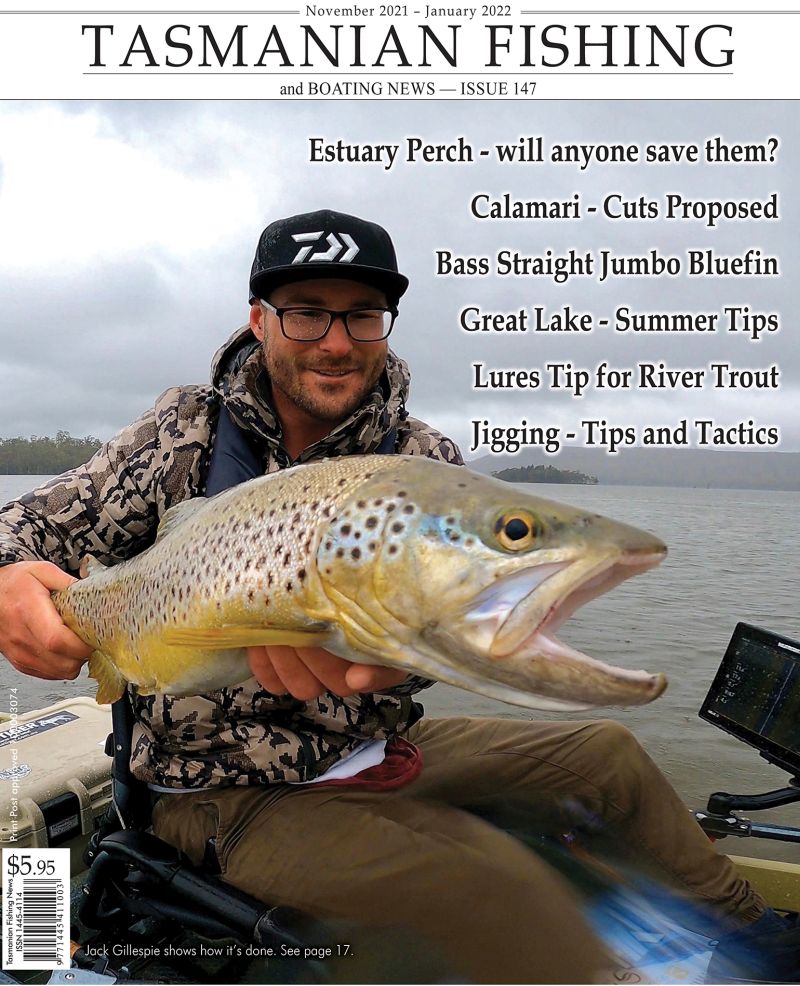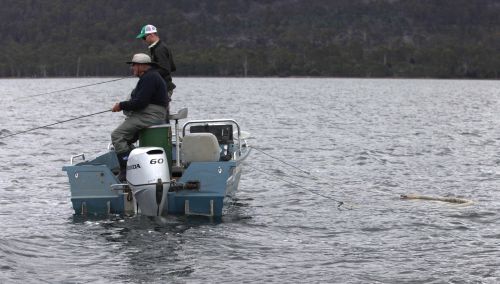From the Archives ...
Atlantic salmon the hard way
Atlantic salmon the hard way
Scott McDonald
The first Atlantic salmon eggs used to begin Tasmania's Atlantic salmon aquaculture industry were introduced into Tasmania in 1984. From these humble beginnings a valuable Tasmanian industry has evolved with a worldwide reputation for having a premium disease free product. This industry provides a spin off to all anglers in the form of regular escapes of salmon from the farms.
Please check all relevant authorities before fishing - www.ifs.tas.gov.au and dpipwe.tas.gov.au . Don't forget issuu.com/stevenspublishing for years of back issues !
Nymphing Maniac
by Neil Grose
There are probably more trout caught nymphing than with any other method during the trout season. But what exactly is meant by nymphing? What are the patterns associated with this method, and what are the best ways to fish them?
- Category: Trout Fishing
- Hits: 6871
Fly Fishing in the Tamar Estuary
by Steve Suitor
Fly fishing in the Tamar Estuary presents a wide variety of species for the angler prepared to explore and experiment.
Each of these different species requires a different technique, a different location and, importantly, a different state of the tide for best results.
- Category: Tamar River
- Hits: 7995
Ikijimi method of killing fish
Once you have caught your fish it is most important that you handle and care for it correctly to ensure that it does not deteriorate to the point it is wasted. Deterioration occurs both through chemical and bacterial processes. Depending on the time taken and subsequent treatment of catch this will affect the taste and texture of meat.
- Category: Saltwater and Estuary Fishing
- Hits: 8391
Fly Casting - Plane and Stance
by Peter Hayes
Casting Plane
Most beginner and intermediate casters do all of their casting with the rod tilted at an angle away from their body. I guess they're scared of being punctured by the fly and whipped by the line. They erroneously believe this angle will keep the fly and line away from them.
- Category: Fly Fishing
- Hits: 6044
West Coast sea trout
by Greg French
It is that time of year again - sea trout time! Sea trout are simply brown trout which spend time in the ocean. In spring they follow huge schools of whitebait into the estuaries and lower freshwater reaches of most of the state's rivers and creeks.
- Category: Trout Fishing
- Hits: 5645
Springtime Fishing at Meadowbank Lake
by Greg French
For the last few years the Inland Fisheries Commission has overseen the release of Atlantic salmon into Meadowbank Lake. These fish are surplus brood stock supplied free of charge by Saltas and they typically weigh 4.5 - 8 kg when liberated.
- Category: Meadowbank Lake
- Hits: 9490
Boat handling basics
This is the first in a series of the Boat Handing Series and it outlines the basic ideas which you will use in operations described in the other brochures in this series.
- Category: Other
- Hits: 6516
The trout season just past has been one of continual change and innovation. New techniques and tackle from overseas, as well as different attitudes to fly dressing and presenting those flies have given progressive anglers much to digest over the closed season. While the cold and wet is with us, it is worthwhile contemplating just how some of these revelations can be applied to our trout fishing.
- Category: Trout Fishing
- Hits: 6954
Trolling for trout
Does line diameter matter?
One of the most significant factors in trolling success for trout in the thickness of your line, claims lure manufacturer Greg "Lofty" Hayes.
"Last season I introduced a fine diameter high breaking strain line to the market, mainly because I was not happy with the lines on the market, mainly because I was not happy with the lines that were generally available.
- Category: Trout Fishing
- Hits: 8173
Kids Stuff - knots
by Michael Bok
In fishing one of the most important things that you can learn is to tie a good knot.
- Category: Other
- Hits: 6218
Subcategories
Current TFBN
Click above for current issue content. The current issue of TFBN is extensive and topical. In Tackle Stores, Newsagents and by subscription.
Delivered to your door for $48 for 2 years (8 issues). To subscribe, send Mike $48 via www.paypal.com.au . (Basic instructions are here) The email is at Contact Us. Your address will be included from PayPal.
Or phone Mike with your c/c handy on 0418129949
Please ensure your details are correct, for Mike to organise delivery.
TFBN Newsletter Sign up Form
Why not submit an article ?
When you have finished for the day, why not have a brag about the ones that didn't get away! Send Mike an article on your fishing (Click here for contact details), and we'll get it published here. Have fun fishing - tasfish.com
Category Descriptions
Here is a list of all of the Article Categories. The number in Brackets, eg (13) is the number of articles. Click on Derwent River and all articles relating to the Derwent will be displayed in the central area.
Articles by Category
-
Rivers (3)
-
Saltwater and Estuary Fishing (149)
-
Kayak Fishing (34)
-
Lakes (1)
-
Great Lake (62)
-
Lake Leake (52)
-
Woods Lake (16)
-
Lake Augusta (11)
-
Huntsman Lake (13)
-
Lake Pedder and Gordon (10)
-
Lake Dulverton (5)
-
Lake Crescent (6)
-
Tooms Lake (10)
-
Lake Mackintosh (2)
-
Lake Barrington (5)
-
Little Lake (8)
-
Meadowbank Lake (5)
-
Lake King William (7)
-
Lake St Clair (2)
-
Western Lakes (12)
-
Arthurs Lake (35)
-
Lake Echo (7)
-
Four Springs (54)
-
Lake Sorell (7)
-
Lake Burbury (6)
-
Other Lakes (57)
-
Brushy Lagoon (18)
-
Little Pine Lagoon (5)
-
Penstock Lagoon (16)
-
Brumbys Creek (7)
-
-
Events (48)
-
Estuary Fishing (0)
-
Coastal Catches (46)
-
Super Trawler (46)
-
IFS, DPIPWE, MAST and Peak Bodies (435)
-
Commercial Interests (98)
-
Other (24)
-
TFBN Back Issues (8)
-
Fly Fishing (67)
-
Trout Fishing (252)
-
Meteorology and Weather (8)
-
Jan’s Flies (50)
-
Tuna Fishing and other Game Fishing (86)
-
Cooking Fish (19)
-
Fishing Information (1)
-
Fishing Books (8)
-
Videos (5)
-
Tackle, Boats and other Equipment (146)
-
World Fly Fishing Championship 2019 (2)
Popular Tags
windyty.com
Visit https://www.windyty.com/
Rubicon Web and Technology Training
Hello everyone, I thought it would be a good time to introduce myself.
My name is Stephen Smith and I have been managing the website tasfish.com since May 2009.
It has been an epic journey of learning and discovery and I am indebted to Mike Stevens for his help, support and patience.
I am developing a new venture Rubicon Web and Technology Training ( www.rwtt.com.au ). The focus is two part, to develop websites for individuals and small business and to train people to effectively use technology in their everyday lives.
Please contact me via www.rwtt.com.au/contact-me/ for further information - Stephen Smith.
From the Archives ... (last chance)
Sea run trout tactics – Craig Vertigan
Sea run trout tactics – Craig Vertigan
During the trout off-season I tend to spend a bit of time chasing bream, to continue getting a fishing fix, and spend time tying flies and dreaming about the trout season to come. It’s a time to spend doing tackle maintenance, stocking up on lures and dreaming up new challenges and goals for the trout season ahead. When the new season comes around I usually spend the first few months targeting sea runners. Sea run trout are simply brown trout that spend much of there lives out to sea and come in to the estuaries for spawning and to feed on whitebait and the other small endemic fishes that spawn in late winter through spring. Mixed in with the silvery sea runners you can also expect to catch resident fish that have the typical dark colours of a normal brown trout as well as atlantic salmon in some of our estuaries that are located near salmon farm pens. Living in Hobart it is quick and easy to do a trip on the Huon or Derwent and is a more comfortable proposition compared to a trip up to the highlands with snow and freezing winds to contend with.
Read more ...


